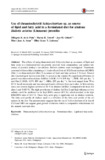Seaweed Gracilariopsis heteroclada, formulated flaked diet, and a combination of both as feed for the abalone Haliotis asinina: Effect on growth and survival

View/Open
Date
2023-01-27Page views
375Metadata
Show full item recordCited times in Scopus
8 readers on Mendeley
Share
Abstract
This paper compares the effect of feeding the abalone Haliotis asinina with seaweed (SW), formulated (FD), and mixed (SW+FD) diets. The feeding experiment, in six replicates, was conducted in a tank facility and lasted for 10 months. At the end of the experiment, abalone fed mixed diets had significantly the highest mean shell length and body weight (45.90±0.19 mm, 22.82±0.31 g), followed by those fed seaweeds (43.47±0.17 mm, 18.25±0.26 g), and lastly, by those fed formulated diets (41.78±0.18 mm, 15.76±0.22 g). Mean growth rates were significantly higher in abalone fed mixed diets at 1.48±0.03 mm and 1.69±0.04 g mo−1 than those fed seaweeds (1.26±0.03 mm, 1.27±0.06 g mo−1) or formulated diet (1.06±0.09 mm, 1.00±0.11 g mo−1). Survival was consistent 1 month from the start of culture until harvest—highest in abalone fed mixed diets (78.81±2.48%), followed by those fed seaweeds (70.12±4.07%), and lastly formulated diet (64.53±4.61%). Moreover, feed conversion ratios (FCR) were significantly lower in abalone fed mixed diets (15.48±0.69) and formulated diet (18.07±3.50) compared with those fed seaweeds (41.31±2.36). The body weight to shell length ratios (BW:SL), which were the same in all treatments at the start of the experiment (0.19 g mm−1), increased to 0.51, 0.44, and 0.38 in abalone fed mixed diets, seaweeds, and formulated diet, respectively. Based on the results of this experiment, giving abalone a mix of formulated and natural diets is the best feeding regime. The importance of a balanced and more nutritional diet on the well-being of the abalone was observed in this study.
Keywords
Haliotis asinina Abalone Gracilariopsis heteroclada Formulated flaked diet SEAFDEC/AQD donkey’s ear abaloneSuggested Citation
Lebata-Ramos, M. J. H., Solis, E. F., & Biñas, J. B. (2023). Seaweed Gracilariopsis heteroclada, formulated flaked diet, and a combination of both as feed for the abalone Haliotis asinina: Effect on growth and survival. Aquaculture International , 31(4), 1995-2009. https://doi.org/10.1007/s10499-023-01069-9
Subject
Taxonomic term
Collections
- AQD Journal Articles [1248]
Related items
Showing items related by title, author, creator and subject.
-
Use of thraustochytrid Schizochytrium sp. as source of lipid and fatty acid in a formulated diet for abalone Haliotis asinina (Linnaeus) juveniles
de la Peña, Milagros R.; Teruel, Myrna B.; Oclarit, Jose M.; Amar, Mary Jane A.; Ledesma, Ellen Grace T. (Springer Verlag, 2016)The effects of using thraustochytrid Schizochytrium sp. as source of lipid and fatty acids in a formulated diet on growth, survival, body composition, and salinity tolerance of juvenile donkey’s ear abalone, Haliotis ... -
Can Ulva reticulata replace Gracilariopsis heteroclada as natural food for the abalone Haliotis asinina?
Lebata-Ramos, Ma. Junemie Hazel; Solis, Ellen Flor D. (Springer, 2021-02-04)Abalone are among the most important fishery resources with high commercial values worldwide, with Haliotis asinina being the most in demand and widely studied species in the Philippines. Abalone culture in the country ... -
Growth rate of the Philippine abalone, Haliotis asinina fed an artificial diet and macroalgae
Capinpin, Emmanuel C., Jr.; Corre, Kaylin G. (Elsevier, 1996)The growth rate of Haliotis asinina fed three diets was evaluated over a 120 day period. Juveniles fed the red alga Gracilariopsis heteroclada and an artificial diet grew faster in terms of both total body weight and shell ...



